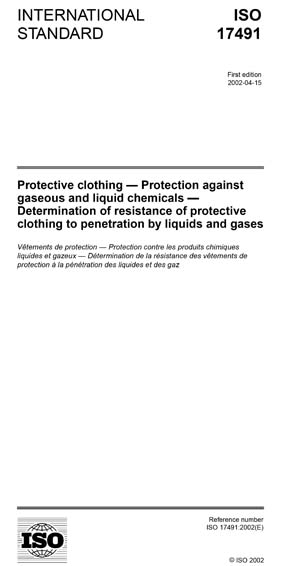Historical
ISO 17491:2002
Protective clothing - Protection against gaseous and liquid chemicals - Determination of resistance of protective clothing to penetration by liquids and gases
This International Standard specifies six different test methods for determining the resistance of complete protective clothing to inward leakage of either gaseous or liquid chemicals (protective clothing integrity). These test methods apply to either liquid or gaseous chemicals, or aerosols, and range in the level of severity.
The six integrity test methods specified by this International Standard are as follows:
- Method A specifies a method for assessing the resistance of a gas-tight suit to outward leakage of air through, for example, essential openings, fastenings, seams, interface areas between items, pores and any imperfections in the materials of construction.
- Method B specifies two different methods for determining the inward leakage of chemical protective suits in a gaseous (or aerosol) environment. The procedure is applicable to gas-tight suits and provides an evaluation of chemical protective suit integrity, paticularly leakage in the breathing zone, under dynamic conditions through the use of human subjects.
- Method C specifies a method for determining the resistance of chemical protective clothing to penetration by jets of liquid chemicals. This procedure is applicable to clothing worn where there is a risk of exposure to a forceful projection of a liquid chemical and intended to be resistant to penetration under conditions which require total body surface cover but not gas-tight clothing.
- Method D specifies a method for determining the resistance of chemical protective clothing to penetration by sprays of liquid chemicals. This procedure applies to protective clothing intended to be worn when there is a risk of exposure to slight splashes of a liquid chemical or to spray particles that coalesce and run off the surface of the garment and intended to be resistant to penetration under conditions which require total body surface cover but not gas-tight clothing.
- Method E specifies an alternative method to method D for determining the resistance of chemical protective clothing to penetration by sprays of liquid chemicals. Method E differs from Method D in that it uses a static mannequin instead of a test subject, it also uses a different spray configuration and duration (1 h compared to 30 min for Method D) and is based on a qualitative determination of observed liquid on the absorbent coverall or interior of the chemical protective clothing.
- Method F is a modification of Method D where the spray has been modified to light spray or mist by use of different nozzles and spray conditions and is intended for partial body protective clothing where the likelihood of splash exposure is low.
Methods C, D, E and F are not appropriate for evaluating the permeation or penetration of liquid chemicals through the material from which the clothing is made.
Content Provider
International Organization for Standardization [iso]






